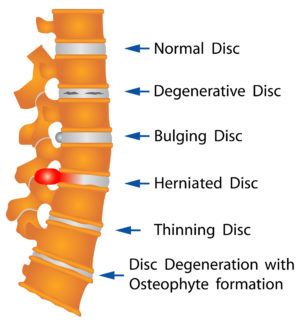What is a herniated disc?
How can you get it?
Herniated discs can be caused by a sudden trauma, age-related wear and tear (disc degeneration), but more commonly by long-term pressure on the spine. Pressure loaded onto our spine is different based on position and posture – lying down vs. sitting vs. standing; sitting hunched over vs. sitting upright. Sitting hunched over creates the most pressure.
Click here to learn how to sit properly at your work desk to produce the least amount of load on your discs.
What is radiating pain?
What are the signs of a herniated disc?
-Pain with bending forward (i.e. washing face/brushing teeth over the sink, tying shoes)
-pain with sitting/driving
-pain with coughing or sneezing
-pain, numbness, and/or tingling in the buttock or leg
-pain improves with walking
-pain improves with lumbar extension (lying on your stomach)
Should I get a X-Ray or MRI?
Physical therapists are able to diagnose a herniated disc based on symptoms and presentation. An MRI is almost always unnecessary.
As we get older, we can see the aging process happen on our faces and bodies – more wrinkles, less muscle mass, thinner skin, etc. Why do people think we only age on the outside? Our insides age too, including our spine (it’s called degenerative changes).
A healthy 25 year old without any complaints of pain can get a MRI and it may show degenerative changes in the spine. Studies show that there is a good percentage of positive findings on MRIs in asymptomatic people.
What does this mean? This means that what you see on the MRI does not necessarily correlate with the pain you are feeling. The MRI is showing you tissue damage but that is not always the cause of your pain. Our bodies are resilient and our tissues adapt to how we move. There’s a good chance your body adapted to your herniated disc or it may have resolved on its own over time. This is why surgery does not always work. This is why physical therapists treat patients based on their symptoms, not based on an MRI finding.
So no, getting imaging done is not always necessary as long as there aren’t any red flags. We say try physical therapy first and if you see no improvement, then maybe an MRI may be a good idea.
How can you fix it without surgery?
What can I do if I am in acute pain?
How do I create stability in my lumbar spine?
How do I create more mobility?
Try out these exercises from our IG post:
View this post on InstagramA post shared by Dr. Ellen & Lauren Chang (@wellnesswithella.dpt) on


Low back pain is too common, from teen to adult, thanks for sharing your little workout . Very helpful.
Way too common! Glad you found it helpful 🙂
Great post! I’ve had issues with my lumbar spine since I was in middle school :O! This is very helpful advice and knowledge to have!
Thank you! Glad to help!
This post is so insightful and full of lots of good information! I love the videos and can’t wait to use some of those moves. I know a lot of people with lower back pain and I’m going to share this post with them! Thanks for posting!
We are so glad you found this post helpful! And thank you for sharing! 🙂
I feel like I have tried EVERYTHING and nothing seems to help my lower back. I have no official diagnosis on what it is, but I appreciate the new moves you shared! It is hard to find variety at this point!
Sorry to hear that! Try out these exercises and see if it helps. Listen to your body and do only what feels good.
My husband has lumbar stenosis, and is in chronic pain. We’ve tried everything, from medications to steroid injections to acupuncture. It would relieve the pain for a while, but then it comes back again. Surgery might be the only option but he is not young anymore and there are other co-morbidities that make surgery a risky choice. I may let him try these exercises. Hope that it would help him with his pain.
Sorry to hear about your husband. Medication and steroid injections are definitely more short term relief because you’re just addressing the symptoms. Being consistent with physical therapy exercises that address the cause of the pain can be more long term. Think about the exercises as medication.
Long time back pain sufferer, happy to gain any insight for preventative measures. Thank you for sharing!
We hope this post helped! 🙂
Thanks for sharing this post! It’s definitely helpful! <3
Thank you! Hope you found it helpful!